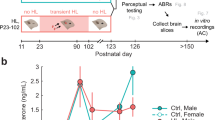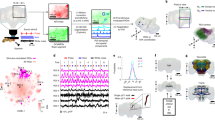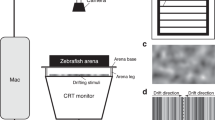Abstract
Early experience plays a powerful role in shaping adult neural circuitry and behavior. In barn owls, early experience markedly influences sound localization. Juvenile owls that learn new, abnormal associations between auditory cues and locations in visual space as a result of abnormal visual experience can readapt to the same abnormal experience in adulthood, when plasticity is otherwise limited. Here we show that abnormal anatomical projections acquired during early abnormal sensory experience persist long after normal experience has been restored. These persistent projections are perfectly situated to provide a physical framework for subsequent readaptation in adulthood to the abnormal sensory conditions experienced in early life. Our results show that anatomical changes that support strong learned neural connections early in life can persist even after they are no longer functionally expressed. This maintenance of silenced neural circuitry that was once adaptive may represent an important mechanism by which the brain preserves a record of early experience.
This is a preview of subscription content, access via your institution
Access options
Subscribe to this journal
Receive 12 print issues and online access
$209.00 per year
only $17.42 per issue
Buy this article
- Purchase on Springer Link
- Instant access to full article PDF
Prices may be subject to local taxes which are calculated during checkout




Similar content being viewed by others
References
Kuhl, P.K. The development of speech and language. in Mechanistic Relationships Between Development and Learning (eds. Carew, T.J., Menzel, R. & Shatz, C.J.) 53–73 (Wiley, New York, 1998).
Harlow, H., Dodsworth, R. & Harlow, M. Total social isolation in monkeys. Proc. Natl. Acad. Sci. USA 54, 90–97 (1965).
Spitz, R.A. Hospitalism: A follow-up report on investigation described in Volume 1. in The Psychoanalytic Study of the Child Vol. 2 (International Universities Press, New York, 1946).
Knudsen, E.I. Capacity for plasticity in the adult owl auditory system expanded by juvenile experience. Science 279, 1531–1533 (1998).
Olsen, J.F., Knudsen, E.I. & Esterly, S.D. Neural maps of interaural time and intensity differences in the optic tectum of the barn owl. J. Neurosci. 9, 2591–2605 (1989).
Brainard, M.S. & Knudsen, E.I. Sensitive periods for visual calibration of the auditory space map in the barn owl optic tectum. J. Neurosci. 18, 3929–3942 (1998).
Moiseff, A. & Konishi, M. Neuronal and behavioral sensitivity to binaural time differences in the owl. J. Neurosci. 1, 40–48 (1981).
Knudsen, E.I. & Knudsen, P.F. Vision calibrates sound localization in developing barn owls. J. Neurosci. 9, 3306–3313 (1989).
Feldman, D.E. & Knudsen, E.I. An anatomical basis for visual calibration of the auditory space map in the barn owl's midbrain. J. Neurosci. 17, 6820–6837 (1997).
DeBello, W.M., Feldman, D.E. & Knudsen, E.I. Adaptive axonal remodeling in the midbrain auditory space map. J. Neurosci. 21, 3161–3174 (2001).
Somogyi, P., Priestly, J.V., Cuello, A.C., Smith, A.D. & Takagi, H. Synaptic connections of enkephalin-immunoreactive nerve terminals in the neostriatum: a correlated light and electron microscopic study. J. Neurocytol. 11, 779–807 (1982).
Zheng, W. & Knudsen, E.I. Functional selection of adaptive auditory space map by GABAA-mediated inhibition. Science 284, 962–965 (1999).
Knudsen, E.I., Esterly, S.D. & du lac, S. Stretched and upside-down maps of auditory space in the optic tectum of blind-reared owls: acoustic basis and behavioral correlates. J. Neurosci. 11, 1727–1747 (1991).
Knudsen, E.I. Mechanisms of experience-dependent plasticity in the auditory localization pathway of the barn owl. J. Comp. Physiol. A 185, 305–321 (1999).
Benson, D.L., Schnapp, L.M., Shapiro, L. & Huntley, G.W. Making memories stick: cell-adhesion molecules in synaptic plasticity. Trends Cell Biol. 10, 473–482 (2000).
Ehlers, M.D. Activity level controls postsynaptic composition and signaling via the ubiquitin-proteasome system. Nat. Neurosci. 6, 231–242 (2003)
Brainard, M.S. & Knudsen, E.I. Experience-dependent plasticity in the inferior colliculus: a site for visual calibration of the neural representation of auditory space in the barn owl. J. Neurosci. 13, 4589–4608 (1993).
Gold, J.I. & Knudsen, E.I. A site of auditory experience-dependent plasticity in the neural representation of auditory space in the barn owl's inferior colliculus. J. Neurosci. 20, 3469–3486 (2000).
Hyde, P.S. & Knudsen, E.I. The optic tectum controls visually guided adaptive plasticity in the owl's auditory space map. Nature 415, 73–76 (2002).
Takahashi, T.T., Carr, C.E., Brecha, N. & Konishi, M. Calcium binding protein-like immunoreactivity labels the terminal field of nucleus laminaris of the barn owl. J. Neurosci. 7, 1843–1856 (1987).
Acknowledgements
We thank R. Desai and D. Ro for assistance with digital tracing of anatomical data; P. Knudsen for technical assistance and owl care; and C. Darian-Smith, Y. Gutfreund, J. Bergan and K. Maczko for critical comments on the manuscript. B.A.L. and E.I.K. conceived the experiments; B.A.L. did the experiments and, with C.v.d.O., analyzed the data and created the figures; and B.A.L. and E.I.K. co-wrote the manuscript. This work was supported by grants to E.I.K. from the NIH (National Institute of Deafness and other Communication Disorders) and the McKnight Foundation. B.A.L. was supported by a National Defense Science and Engineering Graduate Fellowship, an NIH training grant, and a Gerald J. Lieberman Fellowship.
Author information
Authors and Affiliations
Corresponding author
Ethics declarations
Competing interests
The authors declare no competing financial interests.
Supplementary information
Supplementary Fig. 1
Similar distributions of bouton densities in normal and experienced owls. (a) Representative axon segment with boutons (punctate swellings). (b) Bouton frequency measurements in normal and experienced owls. Symbols indicate number of axon segments with the given bouton frequency (X axis). Circles: center projection region, normal owls (mean = 12±4; n = 55). Squares: center projection region, experienced owls (mean = 13±5; n = 98). Triangles: acquired projection region, experienced owls (mean = 11±5; n = 102). (JPG 35 kb)
Rights and permissions
About this article
Cite this article
Linkenhoker, B., von der Ohe, C. & Knudsen, E. Anatomical traces of juvenile learning in the auditory system of adult barn owls. Nat Neurosci 8, 93–98 (2005). https://doi.org/10.1038/nn1367
Received:
Accepted:
Published:
Issue Date:
DOI: https://doi.org/10.1038/nn1367
This article is cited by
-
Structural plasticity upon learning: regulation and functions
Nature Reviews Neuroscience (2012)
-
Structural traces of past experience in the cerebral cortex
Journal of Molecular Medicine (2010)
-
Plasticity and stability of visual field maps in adult primary visual cortex
Nature Reviews Neuroscience (2009)
-
Experience leaves a lasting structural trace in cortical circuits
Nature (2009)
-
Neuroligins and neurexins link synaptic function to cognitive disease
Nature (2008)



